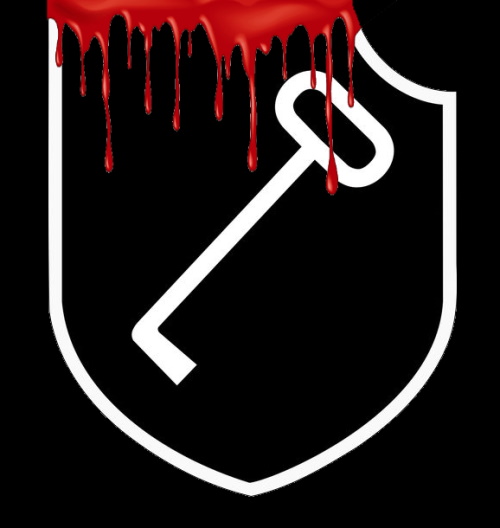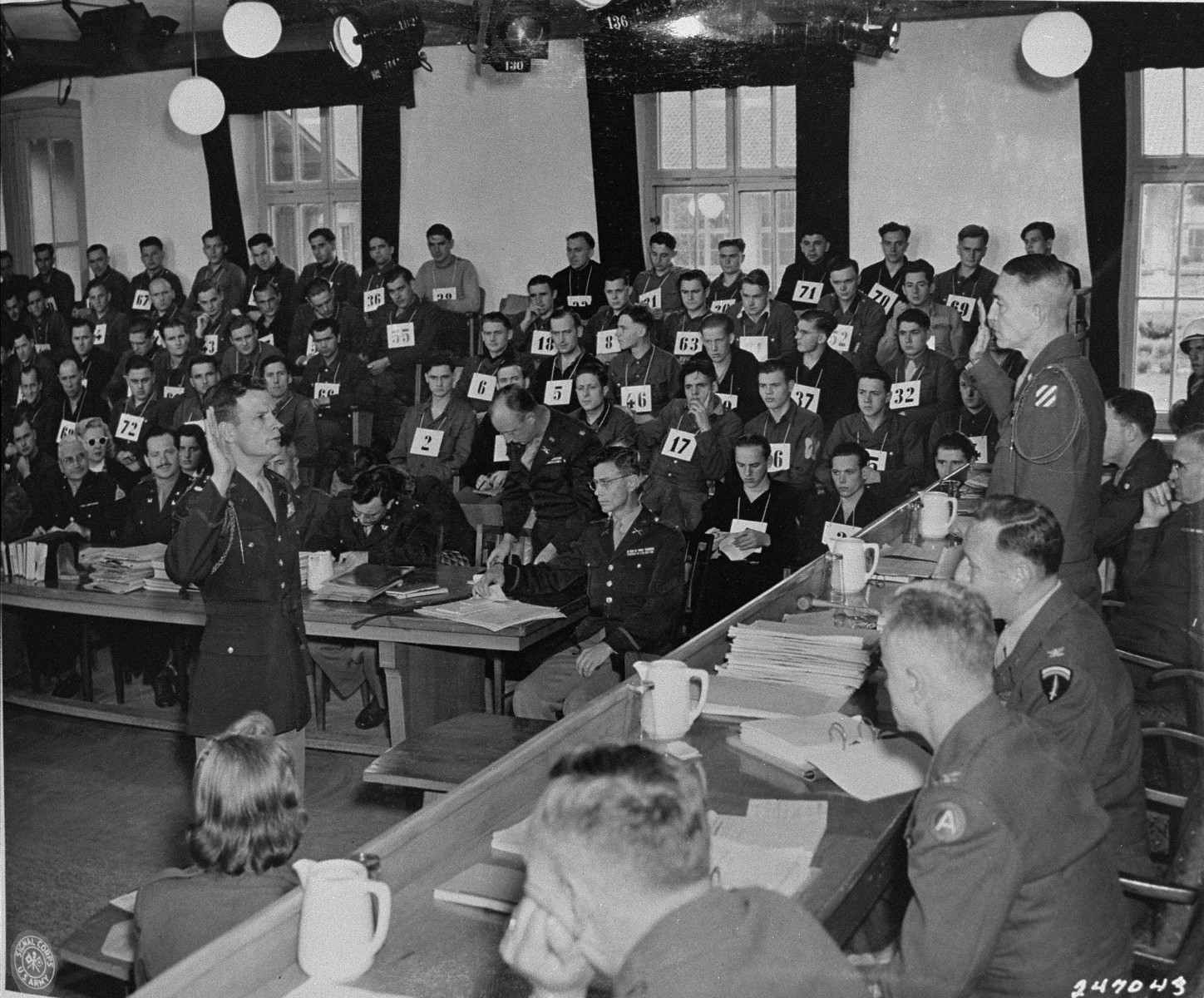The subcommittee found that, in not more than 12 cases of the several hundred suspects interrogated by the war crimes investigation team, mock trials were used in an effort to elicit confessions and to soften the suspects up for further interrogation. The evidence given concerning these trials is extremely conflicting, even among the persons who alleged they were subject to a mock trial. There is no question that mock trials were used. The members of the prosecution staff stated that the results obtained were very unsatisfactory and that they used this procedure, which they called the ‘Schnell Procedure’, on only the less intelligent and more impressionable suspect.
The subcommittee believes the general facts about the trials to be undisputed. There was a table within a room, which was covered with black cloth and on which was a crucifix and two lighted candles. Behind this table would be placed two or three members of the war crimes investigation team, who, in the minds of the suspects, would be viewed as judges of the court. A prisoner would be brought in with his hood on, which was removed after he entered the room. Two members of the prosecution team, usually German-speaking members, would then begin to harangue the prisoner, one approaching the matter as though he were the prosecutor or hostile interrogator, and the other from the angle of a defense attorney or friendly interrogator. The subcommittee could find no evidence to support the position that the suspect was told, specifically in so many words, that anyone was his defense attorney. However, there is no question that the suspect quite logically believed that one of these persons was on his side, and may have assumed that he was his defense counsel. The subcommittee does not believe that these mock trials were ever carried through to where a sentence  was pronounced, nor was any evidence found of any physical brutality in connection with the mock trials themselves.
was pronounced, nor was any evidence found of any physical brutality in connection with the mock trials themselves.
In fact, one witness who was attacking the war crimes investigation team procedures testified that there was no brutality in connection with a mock trial at which he had served as a reporter. When these mock trials had reached a certain point they would be disbanded and the prisoner taken back to his cell, after which the person who had posed as his friend would attempt to persuade the suspect to give a staternent. The subcommittee feels that the use of the mock trials was a grave mistake. The fact that they were used has been exploited to such a degree by various persons that American authorities have unquestionably leaned over backward in reviewing any cases affected by mock trials.
As a result, it appears many sentences have been commuted that otherwise might not have been changed. It is interesting to note why such a procedure was started. Lt Pearl, one of the interrogators, stated that the so-called mock trials were his suggestion, and had been patterned after the German criminal procedure with which the suspects were familiar. Since he was a native-born Austrian and a continental lawyer, the procedures seemed proper to him. Because of the great attention paid to the mock trials by the Simpson Commission, and because Judge Van Roden publicized them so thoroughly, the subcommittee has made a comprehensive study of the pre-trial procedure prevalent on the Continent. The full report on this subject is a part of the subcommittee records. It is a fact that in France, Germany, and Austria there is an established pre-trial examination procedure in which an examining judge hears evidence from any and all persons concerned. Generally speaking, this procedure is only used in the most important criminal cases.
During this pre-trial investigation, the evidence that is secured may be of the most circumstantial nature, but it is later admissible at the real trial for such  probative value as the court desires to place upon it. The subcommittee is full of the opinion that this was the basis for the use of the so-called mock trials, even though they differed in the window dressing and stage effects that the interrogation team used for their own purposes.
probative value as the court desires to place upon it. The subcommittee is full of the opinion that this was the basis for the use of the so-called mock trials, even though they differed in the window dressing and stage effects that the interrogation team used for their own purposes.
2. Solitary Confinement
The subcommittee feels that there is no doubt that many of the suspects in the Malmedy case were kept in separate cells for extended periods of time, but has no criticism or complaint of this normal practice. This is because it was necessary to keep the suspects separated until interrogation was completed. The preponderance of evidence showed beyond a reasonable doubt that such confinement was under the most favorable conditions that the circumstances permitted, and that during this time the men were fed, were warm, and suffered no more inconvenience than one would normally expect to find in an ordinary civilian prison in the USA.
3. Short Rations, Bread and Water
The subcommittee is convinced that, with the exception of one occasion, the suspects in the Malmedy matter were fed three adequate meals a day. Some of the persons who had been interrogated at Schwabisch Hall testified before the subcommittee, and on other occasions, that the food supply was adequate, which corroborates completely the statements of the administrative staff of the prison, including the American medical personnel, who were categoric in stating that the prisoners were well fed.
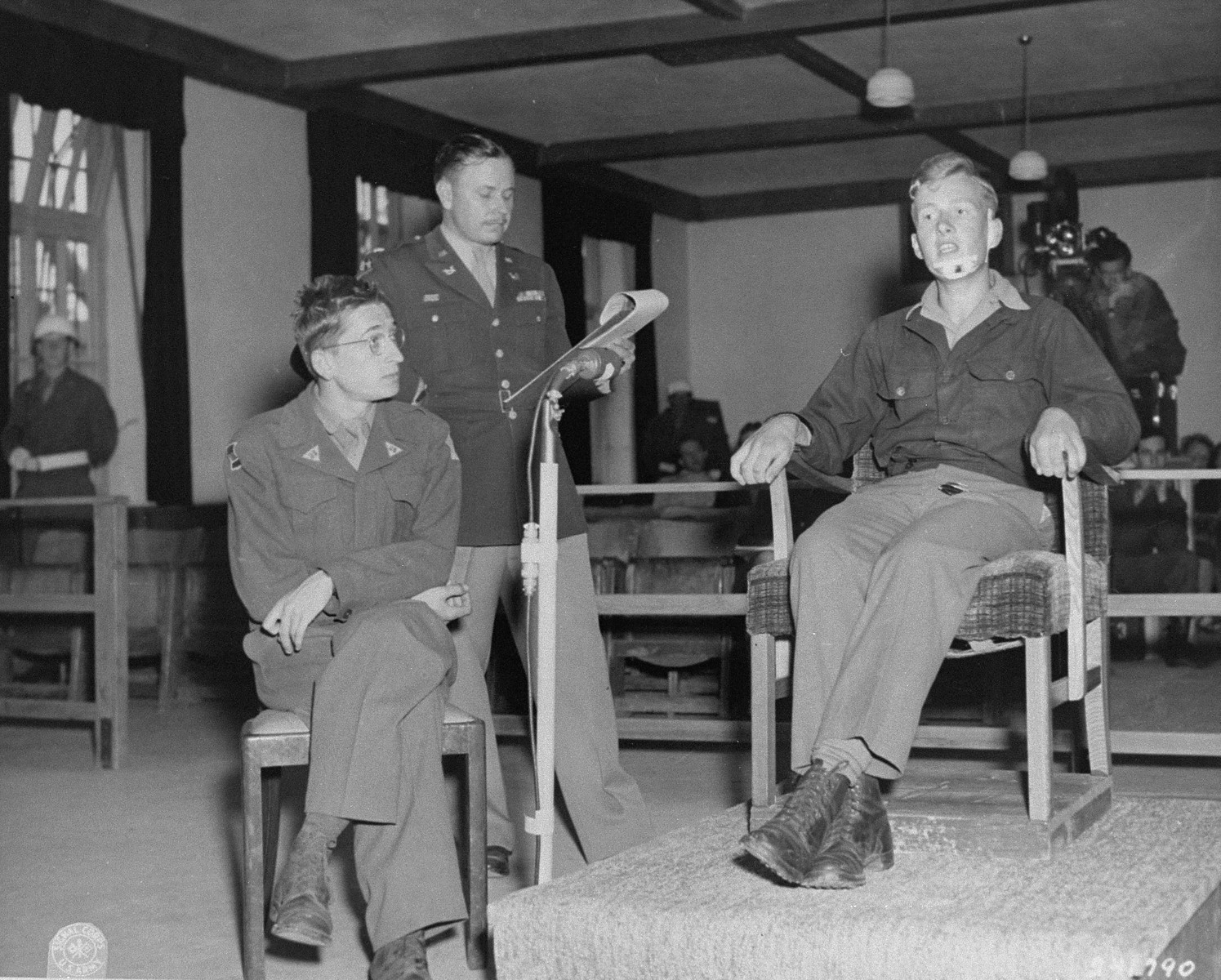 The one exception was in late Dec 1945, during a period of time which varies according to the testimony from four meals, according to the American medical personnel, to 4 days, according to some of the suspects in the case, during which all of the Malmedy suspects were placed on bread and water.
The one exception was in late Dec 1945, during a period of time which varies according to the testimony from four meals, according to the American medical personnel, to 4 days, according to some of the suspects in the case, during which all of the Malmedy suspects were placed on bread and water.
It is an established fact that it was punishment placed on the group because of the efforts of some of the prisoners to communicate with others by marking the bottoms of their mess kits. It was also testified that it required some time to eradicate the markings from these utensils before they were put in use again. The American medical officer in charge stated that when he learned that they were on a bread and water diet, he went to the prison commander and the chief of the war crimes investigation team and told them that he would not permit bread and water punishment to be given unless properly reported. Accordingly, it was stopped. The subcommittee was unable to ascertain accurately as to how many regular meals the prisoners missed. Varying testimony ranged from four meals to 4 days. However, the prisoners received adequate bread and water during this period which punishment is both legal and sometimes used within our own Navy and Marine-Corps. Other than this, there appears to be no evidence that the prisoners were either starved or placed on short rations, and certainly it should not have affected the securing of evidence by the war crimes investigating team.
4. Failure to Supply Drinking Water
A quite frequent allegation made by the suspects was that they received no 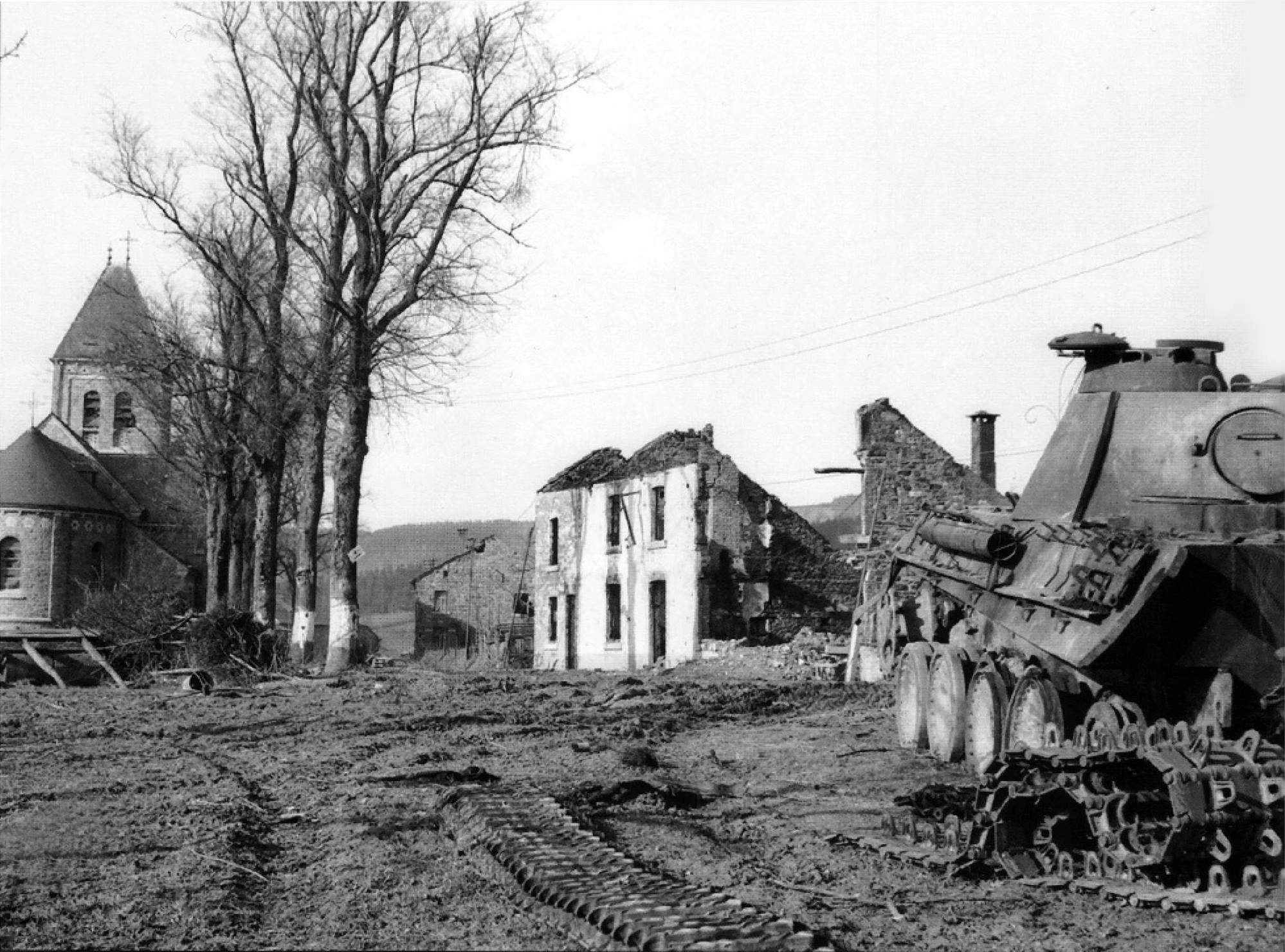 drinking water during the entire period of their incarceration, and were forced to drink from the toilets in their cells. The subcommittee does not feel that there is any foundation for this charge, or competent evidence to support it. This conclusion is arrived at first because of the direct testimony to the contrary by members of the American administrative staff, including the guards, the doctors, medical personnel, and the members of the war crimes investigating team.
drinking water during the entire period of their incarceration, and were forced to drink from the toilets in their cells. The subcommittee does not feel that there is any foundation for this charge, or competent evidence to support it. This conclusion is arrived at first because of the direct testimony to the contrary by members of the American administrative staff, including the guards, the doctors, medical personnel, and the members of the war crimes investigating team.
This evidence taken by itself might not be conclusive, but several of the suspects who were interrogated by the subcommittee testified that they received regular food, a change of underwear once a week, shaving equipment, and washing water every morning, but no drinking water. On cross-examination those who alleged they received no water gave conflicting answers and admitted they received other liquids with their meals.
One, who claimed he never received drinking water during his entire stay at Schwabisch Hall, had previously testified he had been on bread and water for 4 days. There was competent testimony that one of the duties of the guards was to bring water when called for by the prisoners, and not one was denied water when he asked for it. The subcommittee does not feel that such charges can be supported because it is difficult to believe that a group of people who were admittedly supplying all of the necessities of life to the suspects would deliberately deprive them of drinking water.
5. Use of Hoods
 It is an undisputed fact that hoods were placed over the heads of the suspects when they were moved from their various cells and back and forth around the prison. Some few isolated charges have been made that the hoods were bloody and dirty. The subcommittee accepts without question the fact that the hoods were used, but in view of the previous difficulties incurred in this case when no security was used, and the necessity of keeping from one prisoner the knowledge of other suspects who also were being questioned, the subcommittee does not condemn the use of the hoods. Members of the prison administrative staff, testifying before our subcommittee, stated that they personally had inspected the hoods; that they were not dirty, and they had never seen any evidence of blood on any of the hoods. However, the subcommittee recognizes that it would be possible for hoods used for such purposes to become dirty, or, in the event of an accident, or through deliberate action of an individual, for them to have become bloody, without the responsible persons knowing of it. However, the weight of evidence shows to the contrary, and the subcommittee feels that the particular cha,rge of hoods being bloody is unproven.
It is an undisputed fact that hoods were placed over the heads of the suspects when they were moved from their various cells and back and forth around the prison. Some few isolated charges have been made that the hoods were bloody and dirty. The subcommittee accepts without question the fact that the hoods were used, but in view of the previous difficulties incurred in this case when no security was used, and the necessity of keeping from one prisoner the knowledge of other suspects who also were being questioned, the subcommittee does not condemn the use of the hoods. Members of the prison administrative staff, testifying before our subcommittee, stated that they personally had inspected the hoods; that they were not dirty, and they had never seen any evidence of blood on any of the hoods. However, the subcommittee recognizes that it would be possible for hoods used for such purposes to become dirty, or, in the event of an accident, or through deliberate action of an individual, for them to have become bloody, without the responsible persons knowing of it. However, the weight of evidence shows to the contrary, and the subcommittee feels that the particular cha,rge of hoods being bloody is unproven.
6. Beatings, kickings, torture, and other physical brutality
Many of the accused in the Malrnedy trial, as well as the so-called eye 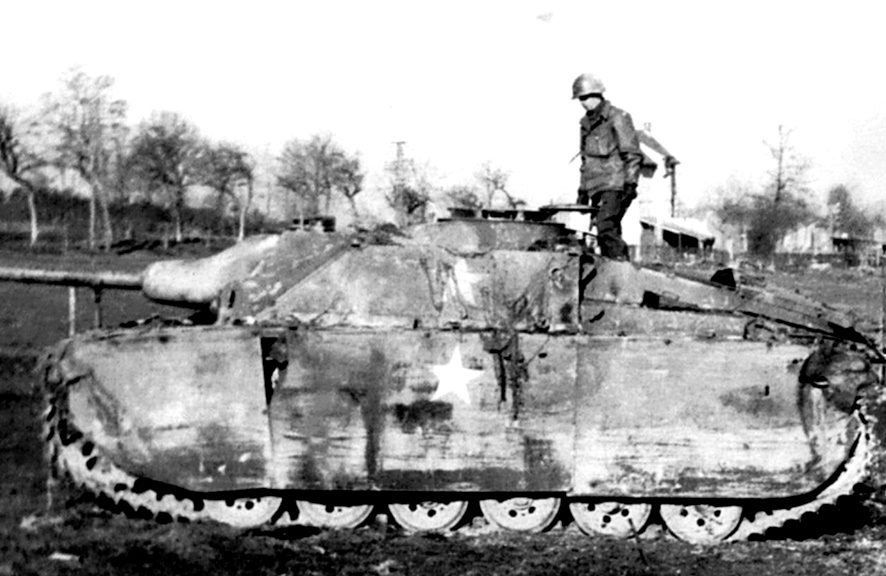 witnesses, have testified that they were beaten severely and sadistically, not only by guards smoving them around the prison, but by the staff of the war crmes investigating team, for the purpose of securing confession. By constant repetition, and the multiplicity of these charges, they have been accepted by some persons as fact. They have been published repeatedly in various forms. In attempting to arrive at the facts in this case, the subcommittee first of all studied the affidavits prepared by the accused some 16 months after conviction, in which the accused claimed beatings, torture, and other duress, for the purpose of securing confessions. The subcommittee noted that an investigation was made of these charges before the trial, when the defense attorneys alleged duress to the war crimes authorities, and an investigation was ordered. Evidence was introduced before the subcommittee to show that only four of those alleging duress at that time claimed to have been beaten, and that those claimed the beatings had been administered by guards and not for the purpose of obtaining confession.
witnesses, have testified that they were beaten severely and sadistically, not only by guards smoving them around the prison, but by the staff of the war crmes investigating team, for the purpose of securing confession. By constant repetition, and the multiplicity of these charges, they have been accepted by some persons as fact. They have been published repeatedly in various forms. In attempting to arrive at the facts in this case, the subcommittee first of all studied the affidavits prepared by the accused some 16 months after conviction, in which the accused claimed beatings, torture, and other duress, for the purpose of securing confessions. The subcommittee noted that an investigation was made of these charges before the trial, when the defense attorneys alleged duress to the war crimes authorities, and an investigation was ordered. Evidence was introduced before the subcommittee to show that only four of those alleging duress at that time claimed to have been beaten, and that those claimed the beatings had been administered by guards and not for the purpose of obtaining confession.
The subcommittee further noted that shortly thereafter when the accused were being tried, nine of the accused took the stand in their own behalf, and of these nine, three alleged physical beatings or mistreatment. The allegations do not appear to have impressed the court at that time. The subcommittee took note of the testimony submitted to it by the defense counsel and in particular the testimony of Col John S. Dwinnell, the associate chief defense counsel, who stated that he had been primarily responsible for the decision that no more of the accused should take the stand in their own behalf. He stated that this decision was made because those who did testify were lying to save themselves to such an extent that they were prejudicing the-cases of other defendants.
